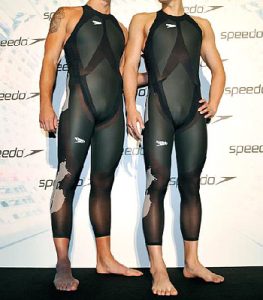Elite-level athletes are notorious for trying to stay one-step ahead.
In the past, this has meant using nutrition science, advanced statistics, and even doping using performance-enhancing drugs. But in the future it may mean doping with technology instead. 3D printing could play a big role in this, further complicating the job of sports’ anti-doping policing force, the World Anti-Doping Agency (WADA).
What is Technology Doping?
Technology doping is an unofficial term, but generally refers to athletes gaining an unfair competitive advantage from their equipment.
Not mentioned in the current version of the WADA Code (global sport’s doping rulebook), “technology doping” is ostensibly considered a violation of the “spirit of sport”. This is a catch-all term to describe sport’s intrinsic values of ethics, honesty, and fair play. While WADA has addressed some technology-related issues (specifically hyperbaric chambers), for now it allows each sport’s International Federation to make their own tech doping rules.
Natural vs. Unnatural Evolution
From soft leather to hard plastic helmets in football, wood to carbon-reinforced polymer rackets in tennis, to the synthetic-surface playing fields themselves common in many sports, technology advancements have always helped evolve sport. All of these undoubtedly have enhanced athletes’ performance, but when does it do so too much?
In 2009, FINA (the international governing body for swimming) drew that line. After 17 world records fell at a single international meet, the Speedo LZR racer swimsuit worn by many of the record breakers came under global scrutiny. FINA decided to ban the elastane-nylon and polyurethane body-length suits which improving swimmers’ speed by increasing buoyancy and repelling water.
Beyond just changing the record books overnight, tech doping has other possible consequences. Unregulated equipment use could lead to an athletic arms race that focuses more on technology than human performance. This in turn could further the gap between traditional sporting nations and those that already can’t afford to keep up resource-wise.
How 3D Printing Could Contribute To Technology Doping
Given how traditionally-manufactured advances in technology have completely changed some sports, it’s not hard to imagine how 3D printing could initiate an even greater revolution. In many ways, it already has.
In 2014, Nike unveiled 3D-printed ‘concept’ cleats like the Nike Vapor HyperAgility, built specifically for American football’s shuttle run drill. Four years later, the company released Nike Flyprint, the “first 3D-printed textile upper in performance footwear.” After capturing athlete data to determine optimal material composition, Flyprint is produced by “solid deposit modeling (SDM), a process whereby a TPU filament is unwound from a coil, melted and laid down in layers.” In other words, it is Fused Deposition Modeling by yet another name.
The first Flyprint was created for Eliud Kipchoge, the Kenyan distance runner who currently holds the world record in the marathon (2:01:39). That record-setting time was registered in the rain, and despite his legendary performance, Kipchoge complained that his shoes absorbed too much water. In response, Nike came back to Kipchoge with the new 3D-printed Flyprint uppers, which are 11 grams lighter than those he wore during his record-breaking run. While it’s impossible to say Kipchoge won’t improve on his world record time even more with or without the shoes, these advancements certainly don’t hurt.
Paralympic athletes are also taking advantage of 3D printing technology. German cyclist Denise Schindler used a prosthetic leg printed by Autodesk in the 2016 Summer Paralympics. While Schindler didn’t appear to have an unfair advantage or even medal, 3D-printed prosthetics that significantly improve para-athletes’ performance seem like they could be the most impactful instance of technological doping in the near future.
The fear would be technology creating cyborg-esque athletes that outperform even ‘able-bodied ones’, which is perhaps why the IAAF (track and field’s governing body) briefly banned “any technical device that incorporates springs, wheels or any other element that provides a user with an advantage over another athlete” such as Olympic and Paralympic runner Oscar Pistorius’ carbon-fiber prosthetics.
The examples go on and on, touching seemingly every sport from biathlon to luge. So far, no international sport body has publicly (issued) a warning regarding 3D-printed equipment—it seems all is fair game as long as the improvement in performance isn’t too obvious or drastic. Given that 3D printing will only become more affordable in the future, maybe IFs consider the playing field level enough as long as nothing turns into a proverbial wood versus metal-level mismatch.
Combatting Technology Doping
But should sports equipment continue to get lighter, stronger, and more customized to the point that it’s creating an unfair advantage, how could tech doping be shorted?
It seems unlikely WADA would add a section to the Code blanket-banning 3D printing, as it would be at odds with its ‘one-size fits all’ approach to policing regular doping. It’s more likely that individual sports will continue to monitor performance as it pertains to their particular sports on a case-by-base basis. A new version of The Code is set to be released in 2021, but currently there’s no indication 3D printing or similar technology is on the table for inclusion.
Should a printing breakthrough become a literal gamechanger, equipment inspections could become mandatory before a game or competition, or done randomly afterward ala urine and blood testing. This would be no job for an ordinary official, and might require a new specifically trained one that knows his polyester from his polypropylene. Counter-technology that can tell “legally-produced” equipment from prohibited technology might also be something sport organizations seek to have developed, undoubtedly signaling the beginning of another giant cat and mouse game akin to the one that policing regular doping already is.
In the end, it will be a human judgment call about which technologies allow athletes to get too far ahead, and which are fair game.
Discuss this news, and other 3D printing topics, at 3DPrintBoard.com or share your thoughts in the Facebook comments below.
Subscribe to Our Email Newsletter
Stay up-to-date on all the latest news from the 3D printing industry and receive information and offers from third party vendors.
You May Also Like
Profiling a Construction 3D Printing Pioneer: US Army Corps of Engineers’ Megan Kreiger
The world of construction 3D printing is still so new that the true experts can probably be counted on two hands. Among them is Megan Kreiger, Portfolio Manager of Additive...
US Army Corps of Engineers Taps Lincoln Electric & Eaton for Largest 3D Printed US Civil Works Part
The Soo Locks sit on the US-Canadian border, enabling maritime travel between Lake Superior and Lake Huron, from which ships can reach the rest of the Great Lakes. Crafts carrying...
Construction 3D Printing CEO Reflects on Being Female in Construction
Natalie Wadley, CEO of ChangeMaker3D, could hear the words of her daughter sitting next to her resounding in her head. “Mum, MUM, you’ve won!” Wadley had just won the prestigious...
1Print to Commercialize 3D Printed Coastal Resilience Solutions
1Print, a company that specializes in deploying additive construction (AC) for infrastructure projects, has entered an agreement with the University of Miami (UM) to accelerate commercialization of the SEAHIVE shoreline...

































